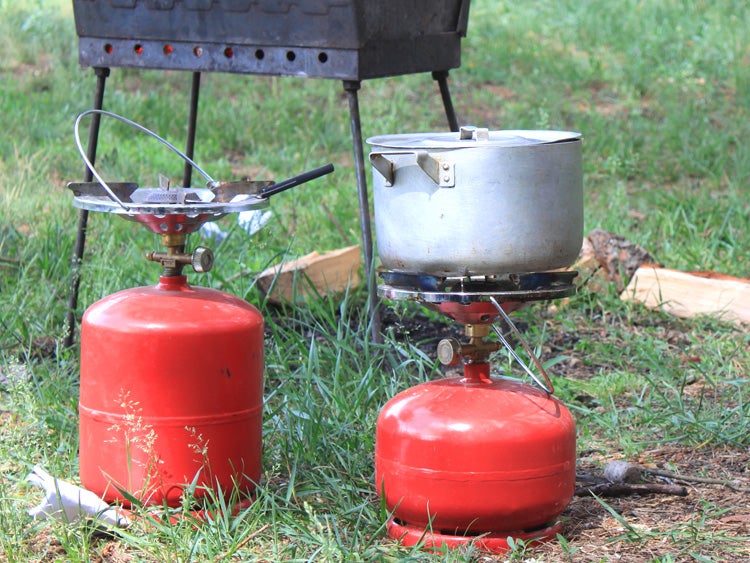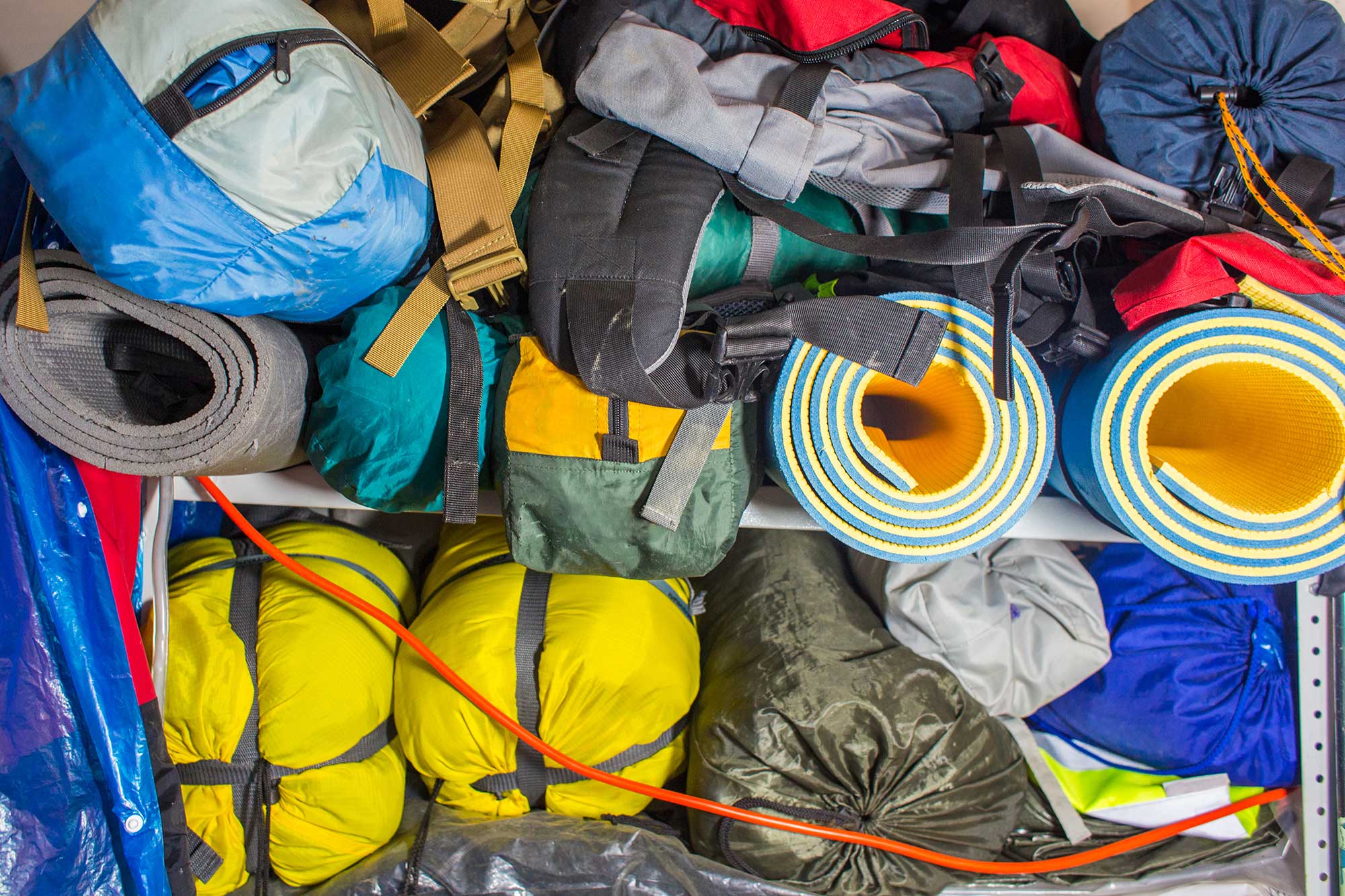Summer is a great time to take out the bins of camping gear and make sure everything is ready for your next adventure—okay, maybe you should have done this a couple months ago. But it’s not too late!
As you’re counting tent stakes and checking for worn patches in your sleeping bag, you might scratch your head over quality and the musty smell of a long winter. We want our gear to last as long as possible. But does gear have an expiration date? Is it time to let go of certain items?
Is it Time to Replace Your Camping Gear? Here’s How to Know.
Everything from sleeping bags and tents to bug spray and batteries can go bad. Here’s a quick guide on assessing what has expired, when to replace your camping gear and how to keep it in top shape for as long as possible.
Sleeping Bags

Sleeping bags do not have an expiration date, but correct care can maintain quality for years. The loft‚ or fluffiness, of a sleeping bag creates warmth by trapping heat between the fibers. The longer the material is compressed, the less it bounces back to its original shape. That’s why sleeping bags often come with a large stuff sack—they need to breathe. Store them in the sack or hang them for optimal fluff.
To revitalize an old sleeping bag, follow the washing instructions to agitate, clean, and dry the bag. Then, sleep in it to see if it still does the job (but bring extra blankets in case it doesn’t). After several years of heavy use or neglect, it may be time to invest in a new bag to stay safe and warm on upcoming adventures.
Tents
With frequent and prolonged exposure to sun, wind, rain, snow, and rough ground surfaces, as well as repeated poking, prodding, entering, exiting, and sleepy time thrashing about, tents take a real beating. And if not properly aired out and stored between uses, they can develop mold and mildew problems. All of these things can bring the life of your tent to a premature end.
There are a few ways of keeping your tent in shape if you want to avoid having to replace your camping gear—especially big purchase gear like tents. Repair snags in the material, or holes poked in the floor with a little Gear Aid Tenacious Tape. A little squirt of lubricant will revitalize door and rain fly zippers so they keep operating properly. Refresh the tent’s DWR the same as your rain gear with a reproofing product. And after using your tent, thoroughly clean and air-dry it before storing it away.
Rain Gear

After several seasons of use—or even one especially heavy season of use—the desire to replace your camping gear might extend to rain gear. For those unsure how rain protective clothing might expire, rain jackets and pants begin to lose their DWR (durable water repellency) effectiveness over time (especially after larger storms). Normal wear and tear, including frequent exposure to sun, wind and rain, not to mention repeated wadding up and stashing—often wet—starts to wear out the water repellent layers and properties of the clothing’s material.
If you notice that rain and water no longer beads up on your rain gear, it may just need to have its DWR refreshed. Both Nikwax and Gear Aid have wash-in and spray-on solutions that can refresh and prolong the life and usefulness of rain gear without need of an expensive replacement. If however, your rain gear’s fabric is starting to delaminate or peel apart, it’s probably time to get a new set.
Dehydrated Food
Do you have a collection of unused dehydrated or freeze-dried food from past trips? You’ve got the green light to eat it next year—chances are, it’s still safe and even flavorful. While there is no strict rule on how long these convenient meals last, some brands offer specific timelines.
Mountain House’s 30-year taste guarantee promises great flavor for three decades. Heather’s Choice has tested their food up to one year after creation, and most Backpacker’s Pantry options created after 2017 will last up to 10 years, except granola (three years) and items with high dairy content, like three-cheese mac and cheese (seven years). Check brand websites for more details on your food’s expiration date.
Cooking Fuel

If you’re the car-camping type, you probably have a stash of partially-used fuel canisters mixed in with your camping gear. You might also think you know when to replace that camping gear: when the canisters are empty, right? But before saving every last drop of your fuel, know which fuel sources expire.
Sealed butane containers—like the ones used with Jetboil Flashes and MSR PocketRockets—won’t expire as they aren’t exposed to air. However, for a liquid stove that requires manual pressurization, like an MSR Dragonfly, replace the fluid after several months.
Older gas may still light, but can also create buildup on the inside of the stove and the fuel line. It’s best to use up what you can each year and then dispose of unused gas at a gas station or local hazardous waste facility.
Sunscreen and Bug Spray
The FDA requires sunscreen manufacturers to put expiration dates on products, with one exception. If there’s no use-by date, check for a manufacture date—it means the sunscreen is effective for up to three years following that date.
According to the Mayo Clinic, it’s best to store sunscreen in the shade and away from direct sunlight to preserve its UV-blocking qualities. Toss discolored, clumpy, or watery sunscreen, as it’s likely been compromised.
Bug spray with DEET can last indefinitely because the long-lasting chemical doesn’t break down. For this reason, you won’t spot an expiration date on DEET sprays. Picaridin products are also safe and effective for many years; toss the container if it’s leaking or the spray is discolored.
Batteries

Have you ever turned a headlamp on only to find it doesn’t work? You may have opened the battery compartment to find a white crust of potassium carbonate. Carbon dioxide from the air and potassium hydroxide from the battery have combined during a passive leak. Avoid this sticky and potentially skin-irritating mess by storing batteries apart from devices.
Got a device with rechargeable batteries? While they don’t exactly expire, batteries can lose power if they sit unused for months, reducing their ability to hold a charge. As a general rule, store nickel and lithium-based batteries at a 40% charge, and store rechargeables at about 60 degrees Fahrenheit.
When you’re ready to put all your gear to the test, don’t head straight to the remote backcountry. Choose a camping spot close enough to civilization that you can get emergency supplies if you learn one of your pieces of gear really has expired.



